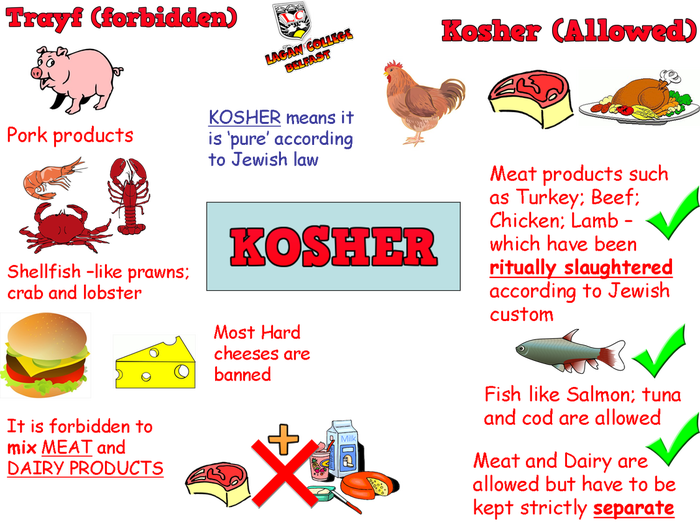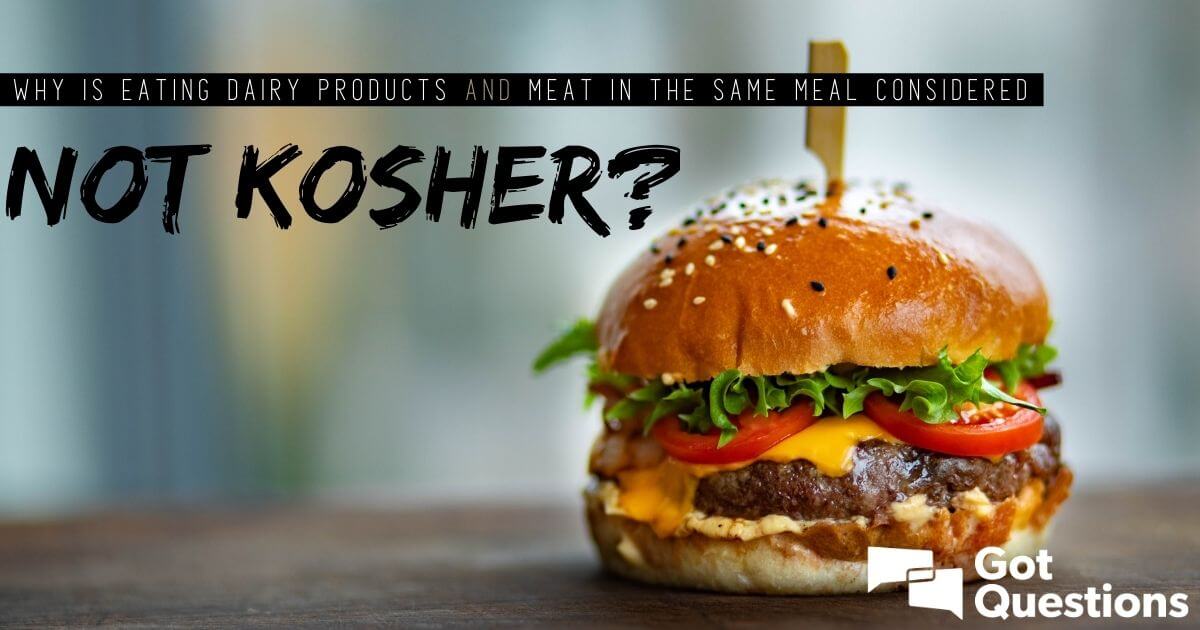Have you ever wondered why Jewish dietary laws strictly separate meat and dairy? It's not just about taste or preference—it's a deep-rooted tradition that spans thousands of years. The prohibition against mixing meat and dairy is one of the most well-known aspects of kosher dietary laws, but there's so much more to it than meets the eye. Let's dive into the fascinating history, religious significance, and modern interpretations of this ancient practice.
Imagine sitting down for a traditional Jewish meal. You might have a plate of tender brisket or a delicious piece of chicken, but you won't find a pat of butter or a glass of milk on the table. Why is that? Well, it all comes down to the principles laid out in the Torah, which dictate how and what Jews can eat. This isn't just about food—it's about faith, culture, and identity.
Today, we'll explore the reasons behind this dietary restriction, how it's observed in modern times, and what it means for Jewish people around the world. Whether you're Jewish or simply curious about this unique tradition, you're in for a treat. Let's get started!
Table of Contents
- The History of Kosher Laws
- Biblical Roots of Meat and Dairy Separation
- Rabbinic Expansion of Dietary Laws
- Practical Implementation in Daily Life
- A Modern Perspective on Kosher Practices
- Are There Health Benefits to Separating Meat and Dairy?
- Cultural Impact on Jewish Communities
- Challenges in Maintaining Kosher Practices
- Global Variations in Kosher Observance
- Conclusion: Why This Tradition Matters Today
The History of Kosher Laws
Let's rewind to the beginning. The kosher dietary laws, or kashrut, are rooted in the Torah, specifically in the books of Leviticus and Deuteronomy. These ancient texts outline what foods are considered "clean" or permissible for consumption. The prohibition against mixing meat and dairy is one of the key components of these laws, but it wasn't always as clear-cut as it is today.
In the early days, the commandment was relatively simple: "Do not boil a kid in its mother's milk." But over time, rabbinic scholars expanded this rule to include a broader separation of meat and dairy products. This development wasn't random—it was a way to ensure that the spirit of the law was upheld in everyday life.
How Did Kosher Laws Evolve?
Think of it like this: the original commandment was like a seed, and over centuries, it grew into a tree with many branches. The rabbis of the Talmud and later generations added layers of interpretation and practical guidelines to help Jews navigate their diets in a way that aligned with religious teachings.
- Separate utensils for meat and dairy
- Waiting periods between eating meat and dairy
- Designated cooking areas for different food groups
These practices may seem strict, but they serve a purpose—to create a clear boundary between what is considered kosher and what is not.
Biblical Roots of Meat and Dairy Separation
Now, let's take a closer look at the biblical roots of this prohibition. The verse "Do not boil a kid in its mother's milk" appears three times in the Torah, which some scholars believe emphasizes its importance. But why this particular commandment? There are several theories:
- Symbolic Meaning: It could represent a respect for the natural order and the bond between mother and child.
- Ethical Considerations: Some argue that it reflects a concern for animal welfare and the avoidance of unnecessary cruelty.
- Religious Distinction: By prohibiting certain practices, the Israelites set themselves apart from neighboring cultures.
Regardless of the exact reason, this commandment became a cornerstone of Jewish dietary law. It's not just about following rules—it's about fostering a deeper connection to one's faith and community.
Rabbinic Expansion of Dietary Laws
Fast forward to the rabbinic era, and you'll see how these laws evolved even further. The rabbis of the Talmud took the original commandment and built upon it, creating a comprehensive system for maintaining kosher practices. Here are a few examples:
Key Rabbinic Innovations
- Separate Dishes: Jews began using separate sets of dishes, utensils, and cookware for meat and dairy to prevent cross-contamination.
- Waiting Periods: Depending on the tradition, Jews may wait anywhere from one to six hours after eating meat before consuming dairy products.
- Parve Foods: Foods that are neither meat nor dairy, such as vegetables, fruits, and grains, are classified as parve and can be eaten with either group.
These innovations were designed to make the laws more practical while preserving their spiritual significance. It's a delicate balance, but one that has stood the test of time.
Practical Implementation in Daily Life
So, how does this all play out in real life? For observant Jews, maintaining kosher practices is a way of life. It affects everything from grocery shopping to dining out. Here's a glimpse into what that looks like:
At Home
Many Jewish households have two sets of everything—plates, silverware, pots, and pans. They may even have separate dishwashers or designated areas for washing meat and dairy dishes. It might sound like a lot of work, but for those who practice these traditions, it's second nature.
On the Go
Eating out can be a challenge for kosher-keeping Jews. They often seek out certified kosher restaurants or bring their own food to events. Some may opt for vegetarian options when dining with non-kosher friends or family.
It's not always easy, but the commitment to these dietary laws is a testament to their enduring importance in Jewish life.
A Modern Perspective on Kosher Practices
In today's world, where convenience often takes precedence, how do these ancient traditions hold up? Surprisingly well, as it turns out. Many Jews find that observing kosher laws enhances their relationship with food and fosters a sense of mindfulness about what they eat.
Why It Matters Today
For some, it's about preserving cultural heritage. For others, it's about aligning with ethical and environmental values. Whatever the reason, the separation of meat and dairy continues to be a meaningful practice for many Jewish people.
And it's not just limited to religious Jews. Some secular Jews and even non-Jews are drawn to the principles of kashrut for their health and ethical benefits.
Are There Health Benefits to Separating Meat and Dairy?
Now, let's talk about the potential health benefits. While the original commandment wasn't based on science, modern research suggests that separating meat and dairy might have some advantages:
- Digestive Health: Some people find that consuming meat and dairy separately is easier on their digestive systems.
- Nutrient Absorption: Certain nutrients may be absorbed more efficiently when consumed in isolation.
- Food Safety: Keeping meat and dairy separate can reduce the risk of cross-contamination and foodborne illness.
Of course, these benefits aren't guaranteed, but they're worth considering for those interested in adopting similar dietary practices.
Cultural Impact on Jewish Communities
The separation of meat and dairy isn't just a dietary guideline—it's a cultural touchstone. It plays a role in Jewish identity, community building, and social interactions. Whether it's a family gathering or a religious holiday, food is often at the center of these experiences.
How It Shapes Jewish Life
From Passover seders to Shabbat dinners, kosher practices influence how Jewish people celebrate and connect with one another. It's a way of preserving tradition while adapting to modern life.
And it's not just about what's on the table—it's about the values and beliefs that are shared around it.
Challenges in Maintaining Kosher Practices
Of course, there are challenges to maintaining kosher practices in today's fast-paced world. From navigating complex food labels to finding kosher options in a sea of convenience foods, it can be a lot to manage. But many Jews rise to the occasion, finding creative ways to stay true to their traditions.
Common Challenges
- Availability of kosher-certified products
- Cost of kosher foods
- Time and effort required for meal preparation
Despite these obstacles, the commitment to kashrut remains strong for many Jews. It's a testament to the enduring power of faith and tradition.
Global Variations in Kosher Observance
Finally, let's explore how kosher practices vary around the world. While the core principles remain the same, local customs and traditions can influence how they're observed. For example:
- In Israel, kosher certification is widespread and readily available.
- In the United States, kosher foods are more common in urban areas with large Jewish populations.
- In Europe, some communities have adapted their practices to accommodate local ingredients and dietary preferences.
These variations reflect the diversity of the Jewish experience and the adaptability of its traditions.
Conclusion: Why This Tradition Matters Today
So there you have it—the fascinating story of why Jewish people don't mix meat and dairy. From its biblical roots to its modern-day applications, this tradition continues to play a vital role in Jewish life. Whether you're Jewish or simply curious about this practice, there's much to learn and appreciate about its history and significance.
Now it's your turn. Have you ever tried keeping kosher? What are your thoughts on the separation of meat and dairy? Leave a comment below and let's continue the conversation. And don't forget to share this article with your friends—knowledge is power, and this tradition deserves to be celebrated!


